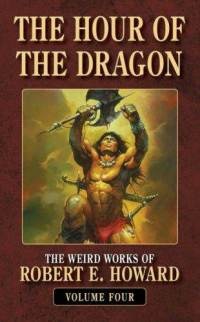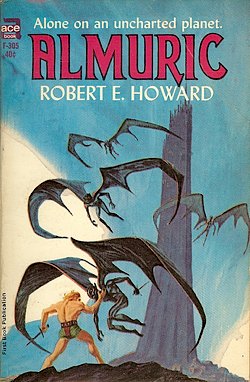Part three of a three part series. Check back at this link to read them all.
All considerations of talent and natural inclination aside, writing was important to Robert Howard for two reasons. Strictly controlled and home and resenting it, he couldn’t have lasted very long at any job where he had to obey someone else. Temperamentally, he had to be a freelance writer. After high school, he made a pact with his father, that his father would pay for him to take a bookkeeping course at a local business college. Afterwards, he had one year to prove he could make a living as a writer. Failing that, he’d have to become a bookkeeper, a career in which Robert would doubtless have gone stark raving mad very quickly.
Fortunately, he got to be a writer, but it was a near thing.
He made his first pro sale with “Spear and Fang,” a caveman tale, which was published in the July 1925 issue of Weird Tales. It was hardly a masterpiece, and it brought Robert a grand total of fifteen dollars, but it was that one-in-a-lifetime breakthrough that writers experience. Robert, who was not conventionally religious, allegedly dropped onto his knees and thanked God on this occasion.
Remember that money was worth a lot more in those days. To understand pulp economics, multiply all numbers by at least ten. In the depths of the Great Depression, a reasonable salary for a low-level office worker—if one was fortunate enough to have a job at all—was about fifteen dollars. A three thousand word story sold to a pulp magazine at one cent a word would earn thirty dollars, two weeks’ salary for a working stiff. Many pulps paid two cents a word. Sell a few stories a month and you could (just barely) live off it. Once Robert really got going, he was making more money than anybody in Cross Plains except the town banker. When he died, his total estate, including a $350.00 car, was valued at $2902.00. That was serious money in impoverished, rural Texas. Of course when Weird Tales got badly behind in payments and owed Robert about $1300.00 at the time of his death (it was eventually paid to his father), that was serious money, too.
After a few more apprentice efforts in Weird Tales, and an unsalable autobiographical novel called Post Oaks and Sand Roughs, Robert began to hit his stride. He is best known today for the Conan tales, but he wrote a lot more.
His first real triumphs were the publication in Weird Tales of “Red Shadows” (August 1928) and “The Shadow Kingdom” (August 1929). The money was fairly good, eighty dollars for the former, a hundred for the latter, but both are also seminal works. In “The Shadow Kingdom” (which was written earlier) Robert single-handedly invented the sword-ands-sorcery story. All the elements are present: swords, magic, monsters, an imaginary or non-historical setting, and of course a barbarian hero. King Kull, a barbarian outcast from Atlantis, becomes king of the equally fabulous realm of Valusia, where he finds his reign threatened by dire sorcery and shape-changing, pre-human serpent men. “Red Shadows” is the first of the Solomon Kane stories, a mixture of history, swordplay, black magic, and African adventures as unreal as anything written by Edgar Rice Burroughs. Kane is an Elizabethan Englishman, a contemporary of Shakespeare, but, like many Howardian characters, a restless outcast, in this case a fanatical Puritan out to right wrongs and defeat evildoers.
Partly out of commercial necessity, Howard wrote series characters who would appear in the course of many stories. This was also the key to his literary method: his great talent was for projecting himself into vividly realized characters who raged across time and space. Many of the Solomon Kane stories are clumsy, but Kane is a great character. Kull is at least an intriguing one, though, after several more tries and only one subsequent success (“The Mirrors of Tuzun Thune,” WT, September 1929) he had to put Kull aside. Perhaps the problem was that once a sword-and-sorcery hero becomes a king, he is no longer free to rove about and have individual adventures. He can only sit on his throne, resisting attempts to depose him, which is exactly what the serpent-men of Valusia were up to. Once or twice, this works, but it is hard to make a series that way. In two of the earliest Conan stories, “The Phoenix and the Mirror” (November 1932) and “The Scarlet Citadel” (January 1933) the same thing happens to Conan, but in “The Tower of the Elephant” (March 1933) where we meet a very young Conan, new to civilization and making his living as a thief, his kingship of Aquilonia a good twenty-some years in his future, with any number of wild adventures in between. The series was a leading feature of Weird Tales for the rest of Howard’s lifetime, although as payments fell further behind and the medical expenses incurred by Howard’s mother’s illness mounted, he inevitably looked elsewhere for a steady paycheck. Toward the end he was talking about giving up on fantasy altogether and concentrating on westerns.
That a Texas writer should write westerns was only natural. It was always Howard’s ambition to write a great, realistic epic of the Southwest. This he never managed, but meanwhile he wrote far more westerns than he did Conan stories, some of them straight shoot-’em-ups, the better remembered ones comic, tall tales, filled with gargantuan cowpokes and cartoon violence. (“I knowed he was too dizzy to shoot straight on account of him having accidentally banged his head on a fence post I happened to have in my hand whilst we was rassling”—from “No Cowherders Wanted.”) There was another long series about a pugilistic sailor variously named Dennis Dorgan and Steve Costigan, who slugged his way through organized bouts and back-alley brawls in exotic ports. Grim, cynical medieval knights slashed their way through stories set in the Crusades. There were also characters (some created in Howard’s teen years) based loosely on Lawrence of Arabia, Americans who donned native garb and swashbuckled and shot their way through the wild hills of Afghanistan. To understand Howard’s career, one must keep in mind that he didn’t just write for Weird Tales. Action Stories and Fight Stories were often his most reliable markets. Toward the end, he began another western series in the prestigious Argosy.
 Being a magazine writer, he wrote few novels. The best and best known, The Hour of the Dragon, was serialized in Weird Tales as pure salvage. It recycled elements of several Conan stories in an unsuccessful attempt to break into the British book market. (One volume of western stories linked together to pass as a novel, A Gent from Bear Creek, did appear in England in 1937. It was the first Howard book.) Another novel, Almuric, left incomplete at his death, is science fiction of the Edgar Rice Burroughs sort, and was probably intended as a serial for Argosy. There were also a handful of detective stories, long on action and short on detection, swashbuckling historicals, pirate stories, straight horror stories (including the classic “Pigeons from Hell”), and much else, including reams of poetry.
Being a magazine writer, he wrote few novels. The best and best known, The Hour of the Dragon, was serialized in Weird Tales as pure salvage. It recycled elements of several Conan stories in an unsuccessful attempt to break into the British book market. (One volume of western stories linked together to pass as a novel, A Gent from Bear Creek, did appear in England in 1937. It was the first Howard book.) Another novel, Almuric, left incomplete at his death, is science fiction of the Edgar Rice Burroughs sort, and was probably intended as a serial for Argosy. There were also a handful of detective stories, long on action and short on detection, swashbuckling historicals, pirate stories, straight horror stories (including the classic “Pigeons from Hell”), and much else, including reams of poetry.
This was an aborted career. Howard was just coming into artistic maturity when he died. It is pleasant, though useless, to speculate how he might have continued if he had lived. Would he have returned to fantasy and even revived Conan in the late ’30s, when he found that Unknown or Fantastic Adventures paid better and more reliably than Weird Tales? Would he, as L. Sprague de Camp suggested, have been on the bestseller lists in the 1950s when swashbuckling historicals of the Frank Yerby sort were all the rage? Would he have actually presided over the sword-and-sorcery boom in the late ’60s? We’ll never know. In the short time he had, though, he made his name immortal.
More books about Robert E. Howard:
Paul Herman. The Neverending Hunt, a Bibliography of Robert E. Howard. Wildside Press, 2008.
Herron, Don, ed. The Dark Barbarian, The Writings of Robert E. Howard, A Critical Anthology. Greenwood Press, 1984. Since reprinted by Wildside Press.
The Barbaric Triumph, a Critical Anthology on the Writings of Robert E. Howard. Wildside Press, 2004.
Schweitzer, Darrell ed. The Robert E. Howard Reader. Wildside Press, 2010.
Darrell Schweitzer is the author of The Mask of the Sorcerer, The Shattered Goddess, and The White Isle, in addition to about 300 published stories, most in the fantasy/horror area. He has been nominated for the World Fantasy Award four times and won it once, as co-editor of Weird Tales, a post he held for 19 years. He is widely published as a critic and reviewer, and is a regular contributor to The New York Review of Science Fiction. He has edited critical symposia about Robert E. Howard and H.P. Lovecraft, and is the author of a book-length study of Lord Dunsany.










